In a month that boasts 4 cat-related national holidays, including the illustrious National Garfield the Cat Day (June 19th in case you were wondering), it only seems right that we focus on one of the biggest issues our feline friends face.

As seen with Garfield’s popularity, everybody loves a fat cat, myself included. They’re so cute and chonky and cuddly; how could you not? Unfortunately, feline obesity is one of the most prevalent and debated topics within the kitty community. And, being honest, there’s really nothing to debate: overweight and obese cats are unhealthy and not living their best lives.
Many studies have been done to understand the factors that play a role in feline obesity. One such study, published last year by Meredith Wall et. al, garnered fairly typical results for the vet science world. A number of factors, all of which are quite easily controlled by the owner, were found to contribute to a cat’s risk for obesity. One such factor is owner conscientiousness; raising our awareness and conscientiousness as pet owners, especially with cats, reduces the risk of pet obesity. This is likely due to us paying more attention to our pets and being more intentional with their care. Cats vocalize with their humans attempting to help us out but, in many ways, they are still very mysterious and can be difficult to read. For this reason, it’s important we take heed the recommendations given us by our veterinarians and also simply “listen” to our cats, both literally and figuratively.
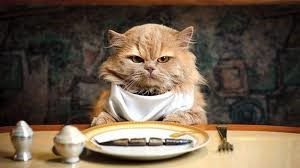
Other factors are related to diet and feeding practices. If you want to be a rock star, look into feeding your kitty home-prepared meals with human grade raw meat and bones. This encourages not only natural chewing but also slower meal consumption. Due to a number of reasons, chief being time, this is likely not a feasible option for you. The next best thing is looking at a primarily canned food diet, as dry food tends to be high in calories and cats aren’t really carb-heavy eaters. Be sure to pay attention to your cat’s specific food likes and dislikes. Then at mealtime provide them a variety of flavors they enjoy.
Why does this matter? Great question! Cats can become bored with their meals. This can lead to them either scavenging (maybe stealing from their brother or sister’s bowl) or simply begging you for “more”. Remember, cats vocalize to us humans and it’s our job to interpret their kitty speak. Not all meows are the same and they certainly aren’t all cries for food, so don’t fall into the trap of rewarding every cry with food or a treat. Reserve special meals for special occasions and use treats as true rewards, such as for play and activity, instead of simply giving a treat because your cat looks so cute or you just feel like it in that moment.
Likely one of the most obvious factors to a lowered risk of feline obesity is being an outdoor cat. You might be thinking ”Duh Keesha, they’re running around outside and burning off all that energy.” Which is 100% true. But there’s more to it and there are ways for you to turn your home into an outdoor wonderland full of the same mental stimulation and opportunity to burn off pent-up energy.
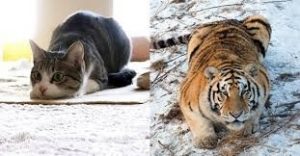
As cat owners, we often take for granted the majestic creatures we call family. Whether overlooked or simply unknown, the fact is our cuddly house cats share 95% of their DNA with the revered lions and tigers (and other wild cats) of the animal kingdom. Crazy, right?! When put in perspective, we can begin to think differently about the part we play in ensuring our cats are living happy, healthy lives.
I mentioned before that cats can become bored with their food, but cats can also eat out of boredom with their environment. As a new cat owner, one of the best ways to make your house a home for your furry friend, is to provide as many different outlets for them to, quite simply, be cats. They want to stalk prey. They want to pounce. They want to scratch and climb and swat. It’s not enough to buy a litter box and some food and water bowls. Cats really are 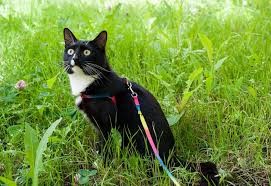 high maintenance; they need more to be comfortable in your home and they’re not going to naturally leash up and go for a walk with you to exercise like our canine companions (that being said, leash training can be done with cats and some end up really loving walks with their humans – it just takes time and lots of patience).
high maintenance; they need more to be comfortable in your home and they’re not going to naturally leash up and go for a walk with you to exercise like our canine companions (that being said, leash training can be done with cats and some end up really loving walks with their humans – it just takes time and lots of patience).
Environmental stimulation is of utmost importance, especially for those cats who stay indoors. It’s been shown that just 20 minutes of play per day can do wonders for overall feline health. The best part? This can be done in quick 2-5 minute spurts. Not all cats are created equally; breed and age can play a part in how active a cat will be. Kittens tend to be higher energy and won’t really need coaxing to run around so use their first year to encourage “positive play”. You’ll instill the right habits for when your kitten becomes an adult and will likely save your couch, doorways, and ankles from the perils of a bored cat. Even if you’re bringing home an older cat, simply having the resources in your home (cat towers, multiple different toys lying around, etc) and encouraging the use of them by playing together with your cat is instrumental to having a happy kitty, safe kitty, and healthy kitty. Pet Central by Chewy.com houses a great blog with a comprehensive list of ways to “exercise” your cat.
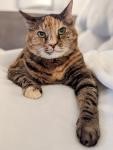
I must end this month’s conversation with a reminder to “adopt don’t shop”, and don’t neglect the older kitties! June is National Adopt a Cat Month and it’s a fact that kittens are the first to go in shelters across America. Middle-aged and senior cats need furever homes too. Although you’re not allowed the opportunity to ensure these older kitties are “trained” to be their best kitty selves in that vital first year; many shelters, like the Animal Welfare League of Alexandria, make up for this and use their time with the cats to encourage these behaviors on your behalf. In doing so, they are actually doing you an even greater service. They’re able to determine, and therefore share with you, the temperament as well as toy and food preferences of the cat you’re looking to adopt.
And if you’re looking to donate to a good cause, the AWLA is this month’s Passionately Pets Shop donation group! In the market for a new kitty? Head over to their adoption site where you’ll find cute faces like Phoebe (pictured above)!
If you find yourself wondering where your cat stands health-wise, check out LitterRobot’s blog discussing healthy cat weight which includes a breakdown of the widely used Purina Body Condition Scale, or BCS. Purina’s BCS emphasizes visual cues as the number on a scale doesn’t tell the whole story when it comes to feline health. Regular vet visits, and actually following the vet’s recommendations, will prove extremely helpful in ensuring your cat maintains a healthy lifestyle. Fat cats might be all the rage but your cat deserves an amazing and long life more than you need “likes” on Instagram. Let’s pledge to change the narrative and make healthy cats trendy again!
Disclaimer: The advice found in this blog is purely informational. ALWAYS consult your vet when it comes to your pet’s overall health and well being.
Written and contributed by: Keesha Lockette, Midday Walker & Vacation Pet Sitter
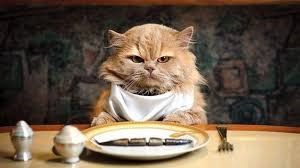




Leave a Reply